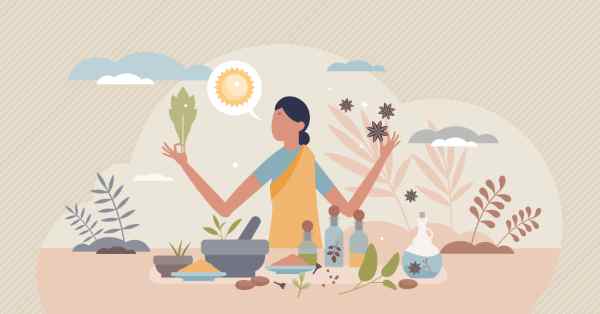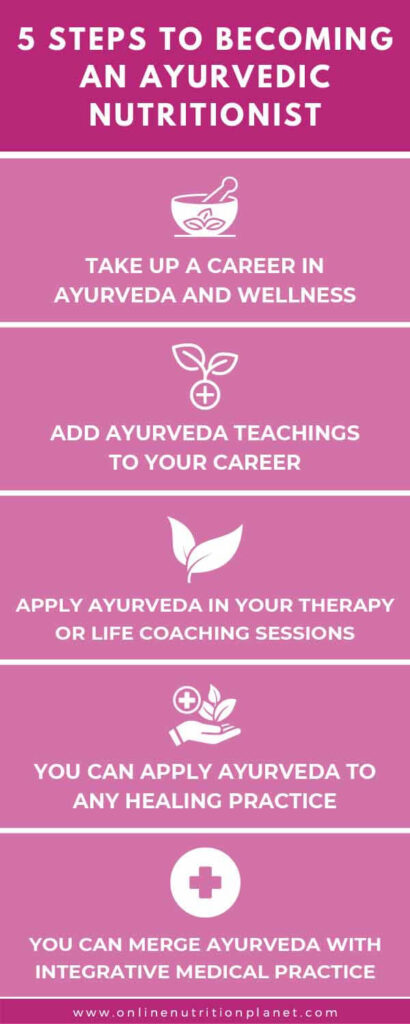Ayurveda is a form of holistic medicine practice that creates a balance between the mind and body. The Ayurveda diet has been a practice that has been going on for thousands of years. To get started on an ayurvedic diet and lifestyle, one has to know their dosha. These doshas determine which illnesses are likely to affect each type, and that’s why there’s a different diet for each dosha.
Becoming an Ayurvedic nutritionist requires a lot of passion for helping others and an ayurvedic certification that will help you treat your clients accordingly. Ayurveda nutrition isn’t a stand-alone course; you can pair it up with others like yoga, massage therapist, and other similar courses. This way, you will find alternative ways to help out your clients.
Article Contents
What does an ayurvedic nutritionist do?
An ayurvedic practitioner is the same as a regular doctor and how they diagnose a patient once you visit the doctor’s office with an ailment. To determine what ails a patient, an ayurvedic practitioner will combine deep analysis of the disease with deep analysis of the patient. Instead of focusing on medicine to treat an ailment, an ayurvedic practitioner will help an individual strengthen their healthy elements in the body to help in their healing process.
Methods of recovery differ from one individual to the next. Ayurvedic medicine believes that ailments arise due to the imbalance of the doshas. So, to get treatment and lifestyle change, an ayurvedic nutritionist will first take you through a thorough analysis to determine your dosha, then help you towards recovery. During this examination, the practitioner will use three steps which include;
- Observation (Darshan): The first step that the practitioner takes is observing the physical conditions by looking at the body movements, body contour, color of eyes & skin, ridges, facial lines, and the quality of the hair, lips, and nails. These are some of the physical observations the practitioner will conduct.
- Touch (Sparsha): In this second step of the analysis, the practitioner conducts a physical touch session to listen to the sounds made by internal organs. This process includes pressing down certain body parts and tapping. In this stage, the practitioner will also conduct a laboratory test.
- Questions (Prashna): During this stage, the practitioner will ask about the patient’s complaints, length of ailment, and disease progression. The practitioner also inquires about your mental and psychological conditions.
What is the typical range of an ayurvedic nutritionist's salary?
In 2020, the median pay range for all the health diagnosing and treatment practitioners (including ayurvedic nutritionists) is $82,420. Another analysis also puts the pay range between $17,204 and $119,938 with the median salary being $51,826.
How can I become an ayurvedic nutritionist?
Even though getting a certification to practice Ayurveda in the U.S isn’t necessary, it is better to study at an institution that gives certificates after completing your studies. Most employers require you to have formal training and certification. The education requirements for accreditation like massage, herbal skincare, or nutrition vary.
The National Ayurvedic Medical Association (NAMA) provides a list of programs that meet the 500-hour practitioner NAMA requirements. Most programs meet the 500-hour to become a Certified Ayurveda Educator (CAE).
To fully become an Ayurveda nutritionist, there are things you must learn. These include:
1. They give fundamental elements
According to the teachings of Ayurveda, every living and non-living thing comprises five fundamental elements. These include; air, earth, space, fire, and water. All these elements are present in everything and everyone but in varying proportions. In human anatomy, tissues and organs are based on these elements. Each element manifests in different ways, and all one has to do is pay close attention to the body and emotions within.
2. The three doshas
These five elements combine to form the three doshas, which cooperate to perform physiological functions in the body. The same way people vary in different ways applies to doshas. Everyone has a different type of Dosha, depending on the distribution of the elements in their bodies.
3. Knowing your Dosha will genuinely help you understand yourself.
Every human has a different combination of the three doshas. This combination is known as the Prakriti of a person. The Prakriti of a person determines every aspect of their body, from the physical to the psychological. These characteristics include; skin type, body structure, weight, mental abilities, inclinations, memory, and temperament.
There are seven different mind and body combinations in the world. Once you learn all of them, that should be the first step to knowing yourself and understanding Ayurveda. You can discover yourself by observing your emotions and paying attention to small details in your body. The seven doshas include; Pitta, Vata, Kapha, Vata-Kapha, Vata-Pitta, Pitta-Kapha, and Vata-Pitta-Kapha.
4. Sometimes doshas are corrupted.
An ideal situation is constant weather conditions and doshas being in balance. But a majority of the time, this isn’t the case. Doshas tend to be imbalanced due to; an ignorant lifestyle, weather, environmental stress, or bad eating habits. These factors result in an imbalance in your doshas which is the root cause of illnesses in Ayurveda.
5. Ayurveda medicines target imbalances.
According to Ayurveda, dosha imbalances result in diseases. So, the whole system of Ayurveda focuses on correcting dosha imbalances. For example, if you have a hormonal imbalance, it means that your Pitta is out of sync. Ayurvedic medicines like yoga, diet, and exercise therapies are all targeted to pacify Pitta.
6. Ayurvedic medicines are not always safe and don't work equally for everyone.
Every Ayurvedic medicine has different energies. Some herbs have cooling energies, while others are warm and stimulating. A Pitta person who keeps taking warm spices like black pepper for a long time may result in a Pitta imbalance over time because warm herbs increase a Pitta. So, most Ayurvedic foods we consume have some effects on the body if not taken correctly.
7. Seasons affect your health.
Different doshas are defined and various seasons. For example, the spring season is predominantly Kapha, and that’s why people experience nasal blockages, allergies, sinuses, and excess mucus. According to Ayurveda, everyone should practice seasonal care to avoid seasonal diseases.
5 steps to becoming an Ayurvedic nutritionist
There are different ways you can incorporate Ayurveda into whatever you are practising at the moment. Ayurveda is universal, and you can use its knowledge in whatever ways possible for the good of other people’s health and well-being.
1. Take up a career in Ayurveda and wellness.
If you are in the U.S, it means that the National American Medical Association sets the standards and levels of practice of Ayurveda. There are three levels of Ayurvedic professionals: health counselor, doctor, and practitioner. All these levels entail different roles of practice in Ayurveda that are client-based.
A Health and Wellness counselor analyses client constitutions and offers lifestyle and nutritional advice to help clients balance their dosha imbalances to heal.
On the other hand, a practitioner or doctor offers more targeted guidance. These professionals analyze the stages of diseases then help the clients manage these imbalances that have already resulted in more severe conditions.
2. Add Ayurveda teachings to your career.
The teachings of this ancient wisdom are universal and can be applied to whatever career it is you are practising. If you’re an educator, the knowledge you have about different body and mind constitutions and their needs, according to the teachings of Ayurveda, can help you communicate better with your students and even set realistic goals for them to achieve.
If you offer service in the food and catering business, you can apply the teachings of Ayurveda nutrition to enhance your cuisine. The Ayurveda principles of cooking will help you create nourishing meals that are healthy, balanced, easy to digest, and genuinely satisfying. In today’s world, most people find it challenging to consume fresh meals that positively impact their health. If you love creating tasty meals, offering these great options can truly help others’ health.
If you work in business and consultation, you can also apply Ayurveda teachings to your career. It doesn’t matter whether you deal with large corporations or small businesses. Understanding the dynamics of health and balance will help you analyze these businesses through a new Ayurvedic lens.
If you have a product line or want to start one, you can apply your Ayurveda knowledge there. There are more people in the world today proffering to use natural products that are locally sourced. You don’t necessarily have to make traditional Ayurvedic products to feel their inspiration, but you can apply the learned wisdom and its guidelines to a product. You can create simple items such as beauty products or makeup.
3. Apply Ayurveda in your therapy or life coaching sessions
Ayurveda teaches all aspects of imbalance, from the emotional and physical to the mental. When coaching someone or acting as their therapist, you tend to look at all aspects of their lives as a whole. Like hobbies, relationships, and work. You can apply Ayurveda physiology and psychology when with a client. As a therapist, counselor, or life coach, this will help you get to the roots of a client’s blockages. You can help your clients adjust their lifestyles and goals according to their personal needs and provide them with natural solutions to manage stress and change.
4. You can apply Ayurveda to any healing practice.
There are many alternative health solutions careers, such as yoga teachers, massage therapists, acupuncturists, herbalists, and physical therapists. Ayurveda can apply to each one of these practises. Once you start using Ayurveda to treat your clients, you’ll be able to enhance your practice into something life-changing. Your clients will become better, and you will be able to transform their lives.

5. You can merge Ayurveda with integrative medical practice.
As much as Ayurveda complements alternative health modalities, it can also pair seamlessly with conventional medicine. Ayurveda teachings can satisfy the rising demand for personalization in the medical industry. Using Ayurveda knowledge, any pharmacist, nurse, or physician can find improved results and new solutions for clients by using their learned Ayurveda practice.
Offering clients natural solutions to their problems will help them heal and probably not need the Western medicine they would have taken simply due to an imbalance. More people are beginning to appreciate alternative health, which is excellent.
Conclusion
Ayurveda is accomodating of all career practises, and you can incorporate it there or even in your day-day life. Practising Ayurveda nutrition will enable you to help many people change their lives and become healthier.






